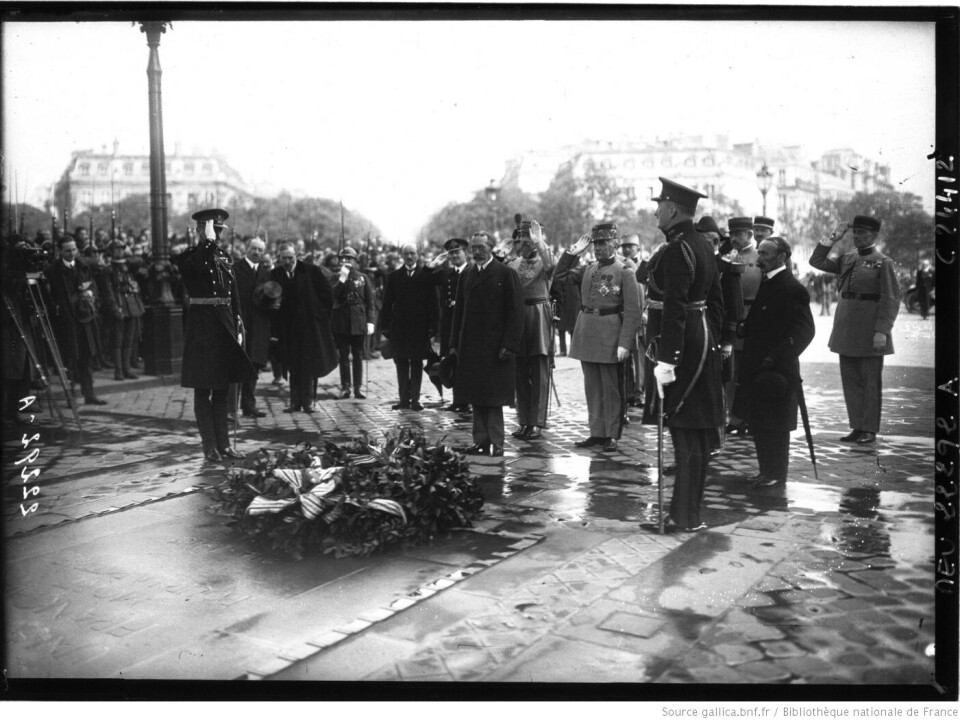-
How many Americans live in Paris - and where else are they choosing in France?
Over a quarter of all US nationals in France live in the capital city
-
Price rises for Netflix in France
The Standard (with ads) and Premium packages are increasing by €24 a year
-
Leclerc supermarkets to sell car fuel at cost price for Easter
The initiative will apply to diesel, petrol, and LPG
French unknown soldier at Arc de Triomphe was one of eight
On the occasion of Armistice Day, we look at how the unknown soldier, buried under the Arc de Triomphe, was chosen

The unknown soldier buried under the Arc de Triomphe in Paris, whose tomb is at the centre of France’s November 11 Remembrance Day ceremonies, was chosen from the remains of eight soldiers, gathered from the main battlefields of World War One.
A soldier called Auguste Thin, then 21, made the choice on November 10, 1920, at Verdun, by laying a floral wreath on one of the eight coffins lined up in front of him.
He chose the sixth coffin lined up in front of him because his regiment was numbered 132 (he added up the numbers) and was in the sixth army corps.
The coffin was transferred by train to a chapel in the Arc de Triomphe for the 1920 Armistice ceremony and then buried in a tomb on January 28, 1921, with an eternal flame lit above it.
Small military ceremonies are still held on the site every evening when the flag is taken down.
Thin, who was a soldat deuxième classe, was a last-minute replacement for the choice ceremony.
Officers decided that a soldat deuxième classe – the lowest rank in the army – of merit, who had served in the war, should make the choice.
The first choice was a recruit from Martinique but hours before the ceremony he was diagnosed with typhoid and Thin was designated in his place.
After the chosen remains were sent to Paris for the burial on January 28, 1920, ceremonies remembering the Armistice have been held by the French president each year, except during the years of the German occupation.
British and French perspectives on the war
In 1925, the British King George V visited Paris and laid a wreath at the tomb of the unknown soldier in Paris (see photo).
France and Britain have similar but slightly diverging historical perspectives of the horror of World War One.
In Britain it is the horrors of the battles of 1916 which dominate, especially the Battle of the Somme where the British army lost 20,000 men in one day.
The losses in 1916 were proportionately heavier in the middle classes, who provided most of the volunteer front-line officers.
One in four officers were killed, compared to one in 10 other ranks.
In France it is in 1914 and the early months of the war, where on one day in August 27,000 soldiers lost their lives, an event which imprinted the horror of the war onto the collective consciousness.
An estimated 400,000 French battlefield casualties occurred in August and September 1914.
The country mobilised early and many of the dead and mutilated in the first months of the war were called-up farm boys or apprentices from rural towns, meaning the dreaded image of the postman cycling around bringing bad news spread quickly right through the most remote corners of the country from early in the war.
Hundreds of thousands of bodies lost
In both countries, the nature of the war, where artillery shells accounted for 70% of the dead and missing, meant that a high proportion of bodies were never found or never recovered for identification and burial.
France and Britain had systems of dog tags, (plaque d’identité militaire) from the start of the war, but shrapnel and blast from artillery meant these were sometimes blown off, which meant that dead soldiers could not be identified if fellow soldiers from their units were not around when their bodies were recovered.
When the final count was done the French army had lost 1,400,000 soldiers, but only 960,000 were found to be buried.
The idea of a national memorial for the dead surfaced early in France and Britain, in 1916 – the British have their own tomb of the unknown soldier in Westminster Abbey.
After the choice ceremony, the coffins of the seven other French unknown soldiers remained in place under guard of honour for the night and were buried together with full military honours under a large wooden cross in the nearby national cemetery of Faubourg Pavé.
It has the graves of 5,722 soldiers, most killed during the battles for Verdun.
Thin, who had been raised as a pupille de la Nation, was working as a grocer in Cherbourg when he volunteered for the army aged 19 in January 1918.
After being discharged from the army he returned to civilian life, married in 1920, and died in 1982, after being decorated just before his death with the legion d’honneur at the arc de la triomphe by President François Mitterrand.
A 3D virtual reality recreation of the choice of remains ceremony has been installed in the Verdun military museum.
Related articles
Why can I no longer order Remembrance Day items to France from UK?
Why chrysanthemums are the French ‘flower of the dead’
How to buy a Remembrance Day poppy in France – or a bleuet
























